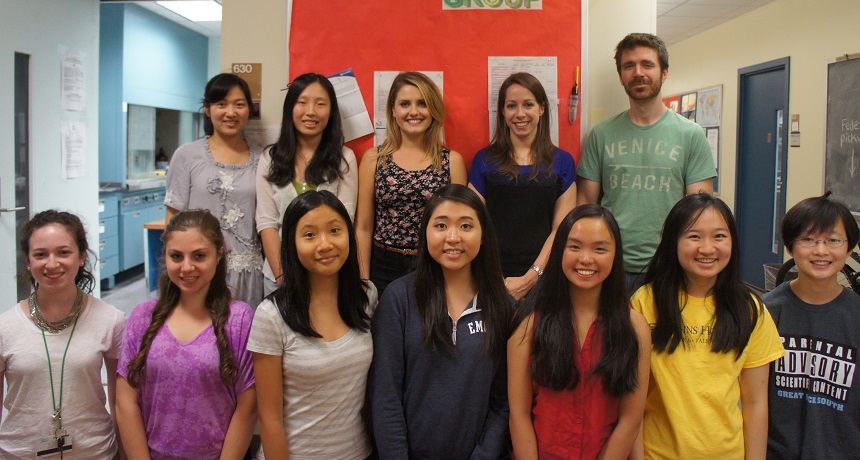Teachers can get teens into college labs
High school teacher James Truglio conducts research each summer, and brings his students along

James Truglio, top right, brings high school students to Peter Tonge’s lab every summer to get hands-on research experience. Bottom, left to right: Teens Brooke Ferber, Courtney Schwartz, Annabelle Ng, Robbin Jang, Samantha Ng, Lucia Geng, Melody Yang. Top, left to right: Grad students Chendi Gu, Yuanyuan Si, Agnieszka Gil and Lauren Spagnuolo.
P. Tonge
Seeing their students enter careers in science, technology engineering and math will give many high school teachers a thrill. Early research experience is a great way to kindle passion for STEM in a motivated student. The problem: Few students have easy access to the types of enriching laboratory environments present at universities. But sometimes a teacher can open the door to those labs. That’s what James Truglio is doing.
A biology and science research teacher at Great Neck South High School in New York, Truglio spends each summer doing research at a nearby university. And he brings high school students with him.
“I was just looking for something to do over the summers and I wanted to do research,” Truglio explains. “I love research. It’s just what I enjoy doing.”
Truglio asked Peter Tonge at Stony Brook University if he could spend the summer in his lab. Tonge’s lab studies biochemistry, including proteins that respond to light and proteins that aid cells in replication. The lab also synthesizes new drugs to help fight bacteria. “I collaborated with [Tonge] when I was a grad student at Stony Brook,” Truglio says. Tonge welcomed the teacher back and told Truglio to bring a student or two with him. To pay for the experience, Tonge and Truglio worked together to write a National Institutes of Health grant. It brought in two years of funding to train high school students during the summers.
That was seven years ago. Now, Truglio returns every summer, students in tow. Tonge uses his own lab funding from the National Institutes of Health and the National Science Foundation on the high-school students. First-timers work directly with Truglio. Typically they are rising sophomores or juniors. Their two- to three- week stints include basic training in biology and chemistry. Students cycle in throughout the summer, with some overlap so that one group can train the next. If the students enjoy the experience, they can come back the next year, when they will be assigned to one of Tonge’s grad students and stay for a full summer.
Of course, Truglio can take only so many students with him, typically between five and six. So during the school year, he encourages motivated students to hunt down summer-research mentors. He guides students as they email scientists, call them and even go to the universities and speak with the scientists directly. “You just need one yes,”he notes, although they might face a lot of rejection before that important yes.
To give them the best chance at getting that yes, Truglio has students in his scientific-research class read papers published by the labs they might like to work in. “They have to write a personal email to every professor,” he explains. Those emails must reference specific work from the scientists’ lab. Then Truglio checks over each drafted email for typos. But after sending 50 to 70 emails, students who have yet to receive a nibble of interest may become discouraged. Eventually, however, someone will get a positive reply. And often, he says, that “gives the rest of them hope.”
Truglio also encourages students to apply to more formal programs , such as the Simons Summer Research Program. But he cautions these can be very competitive.
The most important thing, Truglio says, is for teens to gain a positive research experience. “They need to work on a project, have some independence, just feel like they’re doing science,” he explains. “It’s so important to interact with scientists and learn the language of science — and to always have a good time.”
Tonge is not the only teacher in his area driven to get teens out of the classroom and into the lab. “Long Island is really competitive,” he says. The area has many wealthy school districts where parents want to see their kids do research. As a result, many teachers provide assistance and encouragement to do just that.
But teen interest in research isn’t limited to Long Island. That’s why universities throughout the country host teen-outreach programs. Even colleges and universities without dedicated programs may have scientists willing to take on a student or two. A teacher can encourage students to make the connections and then send the emails that may secure them an opportunity to sample research first hand.
Follow Eureka! Lab on Twitter